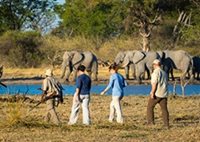
You are not long in South Africa before you hear about “The Big Five,” which refers to a specific group of animals highly prized by the 19th century big game hunters who included professional trophy sportsmen, heads of state and European royalty. Today’s travelers are still stalking the Big Five, though armed with zoom lenses rather than a pair of Purdy rifles.
The Big Five designation was determined by the level of difficulty hunters experienced in both stalking and bagging the animals, not by their physical beauty or size, although both the elephant and the rhino are included in the list. Today, the concept of the Big Five is a handy marketing tool for African safaris and the urge to tick all the boxes remains strong for today’s travelers.
Get to Know The Big Five:
The Lion: Lions live in prides on the savannah. Highly social, female lions maintain a strong bond with their cubs and other females in the pride. The dominant male lion has to fight off fierce competition from adolescent and young adult male lions to maintain his sovereignty.
The Cape Buffalo: The Cape Buffalo are also highly social, moving about in herds. Male buffalo jockey for rank and for access to the females of the herd, often noisily “locking horns” or the “bosses” that cover the entire top of their heads in a tussle.
The Elephant: Elephants are the largest animals in the wild, and the female rules the roost, protecting their young with fierce determination. Despite their size, elephants are adept at hiding in bush grass, making them very hard to track.
The Rhino: There is no such thing as a “white rhino,” a confusion resulting in the Dutch name for the rhino “wyd,” which means “wide” and not “white.” Rhinos are enormous animals with huge horns they use for offense and defense. Rhinos are most often found by water sources since they require frequent hydration to digest the stalky savannah grasses that make up their main food source.
The Leopard: You need eyes in the back of your head to keep track of the leopard, the master stalker of the wild. He’s silent and deadly, stealthily tracking prey for miles before pouncing. Leopards are also canny, often going to great lengths to guard their quarry from other predators. Look up in the trees, and you might see a leopard making short work of a recently-killed animal.
Alexander+Roberts tracks the Big Five on a number of African itineraries, including the unforgettable
Journey to South Africa & Victoria Falls.